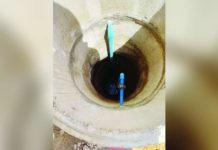ILOILO City – Strengthened immunization coverage must be coupled with good sanitation practices to effectively stop the re-emergence of the polio virus, according to the Department of Health (DOH) Region 6.
It was poor sanitation that triggered the re-emergence of the polio virus in Lanao del Sur and Laguna, said Dr. Glen Alonsabe, DOH-6 epidemiologist.
He particularly stressed the importance of achieving zero open defecation (ZOD) in communities to avoid contaminating the environment and most especially drinking water.
Open defecation refers to the practice whereby people go out in fields, bushes, forests, open bodies of water, or other open spaces rather than using the toilet to defecate.
“Each household must have sanitary toilets,” said Alonsabe.
Polio or poliomyelitis is a highly contagious disease caused by the poliovirus that lives in an infected person’s throat and intestines. It enters the body through the mouth and spreads through contact with the feces of an infected person and, though less common, through droplets from a sneeze or cough.
Symptoms include fever, fatigue, headache, vomiting, stiff neck and sudden onset of floppy arms or legs. In severe cases, it can lead to permanent paralysis or even death. Children under five years of age are most vulnerable to the disease.
So far, Western Visayas remains a polio-free region, according to DOH-6, but more than half of its barangays have yet to achieve ZOD status.
Dr. Sophia Pulmones, DOH-6 Local Health Support Division chief, disclosed that only 45.27 percent or 1,834 out of 4,051 total barangays in Western Visayas have achieved ZOD status.
The province with the highest accomplishment of ZOD is Capiz (75.5 percent) followed by Iloilo (67.6 percent) and Antique (39 percent).
DOH-6 records also showed that no barangay in two highly urbanized cities – Iloilo City and Bacolod City – has achieved ZOD status.
Alonsabe said local government units (LGUs) that have achieved ZOD are issued certifications after being assessed by DOH and other agencies.
As to Iloilo City and Bacolod City not yet achieving ZOD status, he said DOH regional director Marlyn Convocar will be seeking audience with their local chief executives to discuss the concern.
“Kinahanglan gid i-comply sang mga pumoluyo ang ZOD. It is the responsibility of the local chief executives nga ipatuman,” Alonsabe stressed.
Surveillance of acute flaccid paralysis (AFP) cases in the region is ongoing. AFP is defined as the sudden onset of paralysis/weakness in any part of the body of a child less than 15 years of age – a possible sign of polio.
“The more AFP cases nga ma-report, the better for us. We would like to see nga ining mga AFP case will be confirmed and proved nga indi sila secondary to polio that they are secondary to other diseases other than polio,” Alonsabe explained.
From January to Aug. 31, 2019 DOH-6 has recorded 28 AFP cases. It has actually achieved an AFP reporting rate of 1.75 per 100,000 population of children below 15 years old.
Alonsabe said Western Visayas is the highest in the country in AFP cases reporting rate, which means it has a working surveillance.
Dr. Mary Jane Juanico, medical officer III of DOH-6, emphasized that it is also important for households to cook food properly.
Parents and guardians are also encouraged to follow the vaccination schedule of their children.
“It is very important that children maka-mount insigida good immunization and early protection,” she stressed./PN



